A method to analyze visualizations in project management as boundary objects
NEW TITEL; Improving the application of project management visualization through the boundary object framework
The method visualization is used as an important communication tool in project management. It is used in project management through many different methods that either have the sole purpose of being a visual as a communication tool, or have visualization as well as other purposes. I argue that by contextualized visualization within a wider scheme of it's creation and it's use, it will enable us to understand the method more holistically, thus improve it's application and make this method more valuable. This will be done by introducing the notion of boundary objects and understanding visualizations as such. Viewing visualizations as boundary objects thus address the limitation of the visualization method through the generation of three boundary object criteria. This article will initially define visualization and boundary objects. Following this, a discussion of visualizations as boundary objects will be made. This leads to the generation of three boundary object criteria. It's my hope that these criteria will enable primarily project managers to improve their understanding and application of visualizations in project management.
Contents |
Definition of visualization
A visualization is used in project management as a communication tool, where visualization is the process of visualizing as well as the physical (or digital) visual (a visualization). In project management many different forms of visualizations are used e.g. visuals of the organizations' vision, their product development process etc. Visualizations also include visuals of methods such as gantt or PERT charts (which additionally also serves other purposes). Visualization is more specifically defined as "The process of representing abstract business or scientific data as images that can aid in understanding the meaning of the data"[1].
A visualization can be defined by three minimal criteria [3]:
- It is based on data. The purpose of a visualization is to communicate data, thus the data arrives from something that is not immediately visible.
- The result must be readable and recognizable. A visualization must enable actors to learn something about the data.
- It produces an image. Seemingly obvious, a visualization must produce an visual image.
The second criteria observed more closely can lead to the question of how effective a specific visualization is. How is something readable and recognizable and for which actors? I argue that this is highly depending on the context for example the specific method, the vision and which actors are communicating what to whom. Visualization in project management is a method to communicate specific data that can be 'internally' in the project team, as well as to external actors such as e.g. top management, suppliers and customers/users. Introducing communication between different actors leads us to introducing boundary objects.
Boundary Objects
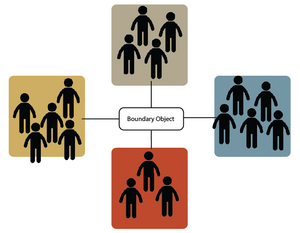
The notion of boundary objects was first introduced by Star and Griesemer in 1989. As they explain:[5]"Boundary objects are objects which are both plastic enough to adapt to local needs and constraints of the several parties employing them, yet robust enough to maintain a common identity across sites... They have different meanings in different social worlds but their structure is common enough to more than one world to make them recognizable means of translation".
Social worlds entails domains in which actors have shared beliefs and commitments about what is important [6]. These actors thereby have a common understanding of certain things and a common let of interests and perceptions. This also entails that actors from different social worlds have different beliefs and understandings of what these things mean and a different agenda and interests. Hereby projects involving actors from different social worlds needs interaction that is focussed on negotiating consensus despite their different perceptions and sometimes conflicting interests. Boundary objects are used as past of this negotiating process and create a common understanding across sites. To be able to do this, boundary objects must be robust or rigid but at the same time flexible. If a boundary object is too flexible but not rigid enough the boundary object will not create a common understanding because it can still be understood differently across the different domains. However, if the boundary object is too rigid it can only be understood in some social worlds and are too detailed or technical to be understood in others.
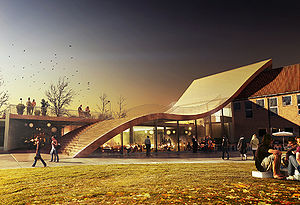
An example could be a drawing of a new cultural center in a municipality involving the architect, the consultants from the municipality and the citizens. However, if the drawing is very technical it might only be used by the architect whereas the consultants and the citizens can not make sense of it. On the other hand if the drawing is too flexible it might leave too much room for interpretation. Thereby, all three groups of actors might expect a different outcome which create different expectations that will not be met and a lot of communication issues. As an effective boundary object the drawing might thereby be rigid enough and show some technical details but at the same time flexible enough so e.g. the citizens do not need to be architects to understand the drawing. Hereby all three groups of actors can have a common understanding of the project overall, it's rigid and flexible enough so all three groups can use the drawing for their own purpose in their own social world but also create a common understanding across the domains. Boundary objects have the possibility when used effectively to enable integration of knowledge across boundaries and thereby bridge the gaps between the social worlds. In the example it could be that through the drawing the all the actors can communicate expectations and needs to the other actors and negotiate what the cultural center should include and exclude.
It's important to understand the context in which the boundary objects are used. This not only entails which different social worlds the actors inhabit but also the context in which the boundary objects came into being. In the example above, the boundary object will differ according to which set of actors that created it e.g. if the consultants and citizens made the drawing without the involvement of the architect it might not even be possible to actually build the building. However, if the architects made the drawing exclusively, it might entail a building that does not meet the need of the two other groups. This could for instance be in relation to the price or the actual use of the building. Susan Leigh Star stresses the fact that boundary objects are created when members of different social worlds or communities much collaborate and negotiate so they have a specific, common "work and information requirement"[8].
Visualization as boundary objects
Decades of research support that heterogeneous project teams preform better than homogeneous project teams thus giving one explanation for why these teams are oftentimes heterogeneous[9] [10], which in turn makes communication critical for successful project management. I argue that a limitation of the visualization method is, that it is mostly concerned with the method and visual itself but not it's context of use. However, seeing project management visualization as boundary objects enables us to view the method more holistically and include the notion of the entire process of creation, use as well as the visual itself. The boundary object framework thus extent our understanding of visualization. Visualization can be used as a method to communicate data in project management and thus create and communicate a overview of the date. However, as a boundary object, visualization also acts as objects enabling the necessary social interaction and integration of knowledge across boundaries, which in the end enables knowledge sharing and integration of information within an organization [11]. Visualizations as boundary objects thus not only communicate specific date but it also helps create a common understanding with shared meanings in a otherwise diverse group o people.
Understanding visualizations as boundary objects make sense in the wider scheme of project management including diverse actors both because the boundary object framework touch upon different social worlds as well as frame boundary objects as communication tools interaction between these different worlds.
Criteria Development
Three boundary object criteria will be developed in order to improve visualization in project management. All three criteria are intertwined and cannot be seen as separated. Understanding these criteria is a more iterative process of ‘deciding’ at one criteria, going to the next and getting more knowledge. Following then turning back the first criteria and correcting it.
Flexibility of the actual object
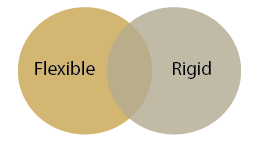
Boundary objects need to be both flexible yet rigid and this criterion is about understanding this balance. This criterion is focused on the physical/digital object. The involved actors are from different social worlds thus per definition they have different way of understanding the boundary object. If the visualization is too flexible all actors will have a different understanding of it and can find common ground thus the visualization will not communicate ‘anything’ across boundaries. On the other hand – by having a visualization that is too rigid, actors will be excluded since they will not be able to make sense of it and the date and overview the visualization should communicate will be lost for these actors.
When visualization is too flexible, it can be understood in ways that vary too much thus the actors do not have a common understanding. In relation to timelines such as Gantt charts a task might be too flexible defined. The actors could then scope the task differently and ending in not being able to synthesis each actors contribution. Another example could be that the allocation of tasks are too flexible. An outcome could be that team member ‘’A’’ believes team member ‘’B’’ will deliver the task and ‘’B’’ believes ‘’A’’ would do it. They may even deliver ‘wrong’ tasks again based on different interpretation of the data in the visualization.
On the other end of the scale would be a visualization being too rigid and constrained. An example could be a very detailed financial template visualized. The economist can make sense of it. However, let’s say the project team includes a graphic designer that does not know anything about finance. The visualization is then so specific, detailed and ‘closed’ that the designer might not be able to make any sense of it or use it at all. A boundary object both too flexible or too rigid, will loose it’s effectiveness as boundary object to create a common understanding and integrate knowledge across boundaries.
Degree of common understanding
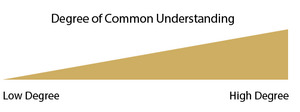
Finding the right balance between flexibility and rigidity depends on the actors that are involved. Essentially how high degree of common understanding there is in the context of the specific visualization.
- First step is to consider which actors the boundary object need to bring together. Is the visualization for internal use in the project team or will it be used for also e.g. top management.
- Second step is then considering how much the social worlds vary thus how different all the included actors interpretations could be.
High degree of common understanding could be found in an establish project team that have use the specific visualization before and thereby might already have created a similar understanding of the key attributes. If this is the case, the boundary object can be more rigid and the need for flexibility is lower. Low degree of common understanding means that the actors are from very different social worlds, thereby we are assuming the do not have any common understanding of the visualization already.
Integration level
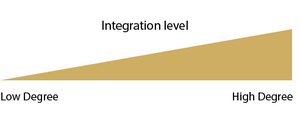
Levina and Vaast [15] differentiate between designated boundary objects and boundary objects-in-use. Designated boundary objects are ’artefacts that are designated as valuable for boundary spanning, due to their design and properties’. Typical, powerful actors such as top managers designate a specific tool to be used in the project, which may or may not become boundary objects-in-use. Boundary objects-in-use are ’artefact that have meaning and are useful for the work practices of different groups of actors, and which acquire a common identity across groups’. For example, within a manufacturing plant, Bechky [16] found that the designated boundary object was the engineers’ blueprint of a machine. However, prototypes of the actual machine became the actual boundary objects-in-use since they had much more meaning and thereby were more useful for the work being done by assemblers and technicians. Whether it becomes a boundary object-in-use is determined by how an artefact is used. Thus, boundary objects are perceived as useful when they are in use. However, the use can appear within different episodes, such as limited to discussion in the project planning or repeating use throughout the entire project.
This criteria is about to which degree the visualization is integrated in the project work.
example...
Limitations
Limits of the article
- Difference between physical and digital visualizations
- Other contributors to imporve effectiveness of visualizations
- Only use the overall of the boundary object framework and not theories and articles that already address improvement of boundary objects.
Conclusion
I conclude...
Bibliograhy
A short description of key references.
Star and Griesemer
References
- ↑ Multimedia and graphics glossary - Visualization. [online] http://whatis.techtarget.com/definition/visualization. [Accessed 20. September 2015].
- ↑ WHITEPAPER: The visual Approach to Improving Project Management [online] http://blog.mindjet.com/2015/01/whitepaper-pm-visualization/ [Accessed 27. September 2015].
- ↑ Visualization and Visual Communication. [online] https://eagereyes.org/criticism/definition-of-visualization. [Accessed 20. September 2015].
- ↑ Eva S. Hansen (2015) ‘A visual of a Boundary object’.
- ↑ Star, S. L. and Griesemer, J. R (1989) 'Institutional Ecology, "Translations" and Boundary Objects: Amateurs and Professionals In Berkeley's Museum of Vertebrate Zoology, 1907-39', Social Studies of Science 19(3): 387-420.
- ↑ Hodgson, D. and Cicmil, S. (2006) 'A framework for understanding sense-making in projects', Making Projects Critical (Management, Work and Organisations: 321-322.
- ↑ Mariehøj Kulturcenter. [online] http://www.rasmusbronnum.dk/category/arkitektfaglighed/page/24/. [Accessed 27. September 2015].
- ↑ Boundary Objects: A field Guide. [online] http://scalar.usc.edu/works/boundary-objects-guide/boundary-objects?path=index. [Accessed 27. September 2015].
- ↑ How Diversity Makes Us Smarter. [online] http://www.scientificamerican.com/article/how-diversity-makes-us-smarter/. [Accessed 21. September 2015].
- ↑ How Diversity Spells Success. [online] http://www.ryerson.ca/news/news/Research_News/20140228-how-diversity-spells-success.html.
- ↑ Chesley, J. and Wenger, M. (1999) 'Transforming an Organization: Using Models to Foster a Strategic Conversation', California Management Review 41(3): 54-73
- ↑ Eva S. Hansen (2015) ‘A visual of flexibility and rigidity.
- ↑ Eva S. Hansen (2015) ‘A visual of degree of common understanding.
- ↑ Eva S. Hansen (2015) ‘Degree of Integration.
- ↑ Levina, N. and Vaast, E. (2005) 'Strategic Planning as an Integrative Device', Administrative Science Quarterly 49(3): 337-65.
- ↑ Bechky, B. A. (2003b) 'Object lessons: Workplace artifacts as Representations of Occupational Jurisdiction', American Journal of Sociology 109(3): 720-52
Making Projects Critical is an edited collection contributed by a range of international scholars linking the area of project management with critical management perspectives. Challenging recent debates on inherent problems in project management, the text considers project management within a wider organizational and societal context.